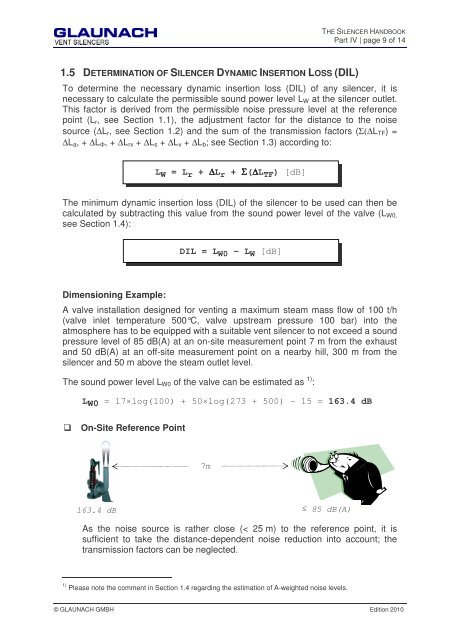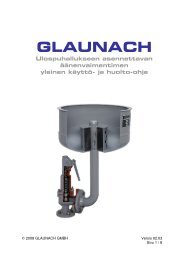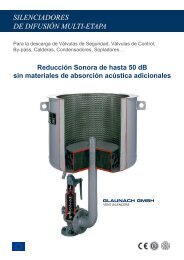1. acoustic dimensioning - GLAUNACH Vent Silencers
1. acoustic dimensioning - GLAUNACH Vent Silencers
1. acoustic dimensioning - GLAUNACH Vent Silencers
You also want an ePaper? Increase the reach of your titles
YUMPU automatically turns print PDFs into web optimized ePapers that Google loves.
<strong>1.</strong>5 DETERMINATION OF SILENCER DYNAMIC INSERTION LOSS (DIL)<br />
THE SILENCER HANDBOOK<br />
Part IV | page 9 of 14<br />
To determine the necessary dynamic insertion loss (DIL) of any silencer, it is<br />
necessary to calculate the permissible sound power level LW at the silencer outlet.<br />
This factor is derived from the permissible noise pressure level at the reference<br />
point (Lr, see Section <strong>1.</strong>1), the adjustment factor for the distance to the noise<br />
source (∆Lr, see Section <strong>1.</strong>2) and the sum of the transmission factors (Σ(∆LTF) =<br />
∆La, + ∆LΦ, + ∆Lrx + ∆Ls + ∆Lv + ∆Lb; see Section <strong>1.</strong>3) according to:<br />
The minimum dynamic insertion loss (DIL) of the silencer to be used can then be<br />
calculated by subtracting this value from the sound power level of the valve (LW0,<br />
see Section <strong>1.</strong>4):<br />
Dimensioning Example:<br />
A valve installation designed for venting a maximum steam mass flow of 100 t/h<br />
(valve inlet temperature 500°C, valve upstream pressure 100 bar) into the<br />
atmosphere has to be equipped with a suitable vent silencer to not exceed a sound<br />
pressure level of 85 dB(A) at an on-site measurement point 7 m from the exhaust<br />
and 50 dB(A) at an off-site measurement point on a nearby hill, 300 m from the<br />
silencer and 50 m above the steam outlet level.<br />
The sound power level LW0 of the valve can be estimated as 1) :<br />
LW0 = 17×log(100) + 50×log(273 + 500) - 15 = 163.4 dB<br />
On-Site Reference Point<br />
163.4 dB<br />
L W = L r + ∆L r + Σ(∆L TF) [dB]<br />
DIL = L W0 – L W [dB]<br />
7m<br />
≤ 85 dB(A)<br />
As the noise source is rather close (< 25 m) to the reference point, it is<br />
sufficient to take the distance-dependent noise reduction into account; the<br />
transmission factors can be neglected.<br />
1) Please note the comment in Section <strong>1.</strong>4 regarding the estimation of A-weighted noise levels.<br />
© <strong>GLAUNACH</strong> GMBH Edition 2010








